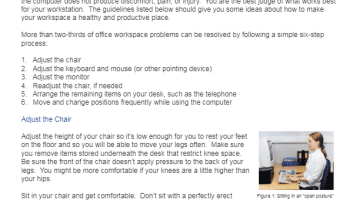Adjusting your office environment makes your workspace personal. You can adjust it so your use of the computer does not produce discomfort, pain, or injury. You are the best judge of what works best for your workstation. The guidelines listed below should give you some ideas about how to make your workspace a healthy and productive place.
More than two-thirds of office workspace problems can be resolved by following a simple six-step process:
- Adjust the chair
- Adjust the keyboard and mouse (or other pointing device)
- Adjust the monitor
- Readjust the chair, if needed
- Arrange the remaining items on your desk, such as the telephone
- Move and change positions frequently while using the computer
Adjust the Chair
Adjust the height of your chair so it’s low enough for you to rest your feet on the floor and so you will be able to move your legs often. Make sure you remove items stored underneath the desk that restrict knee space. Be sure the front of the chair doesn’t apply pressure to the back of your legs. You might be more comfortable if your knees are a little higher than your hips.
Sit in your chair and get comfortable. Don’t sit with a perfectly erect posture unless you routinely sit with perfect posture. Most people prefer to sit with an “open posture,” (Figure 1) leaning slightly toward the rear of the chair. Some studies have shown that an open posture may be better for the back than a perfectly erect posture.
Adjust the backrest so it firmly supports the lower, curved part of your back and allows you to sit in a comfortable position. If the backrest can’t be adjusted so it supports the lower back, attach a lumbar cushion so it will fit into the curved part of the back. Be sure the cushion supports the lower back without causing you to sit too far forward in the chair.

